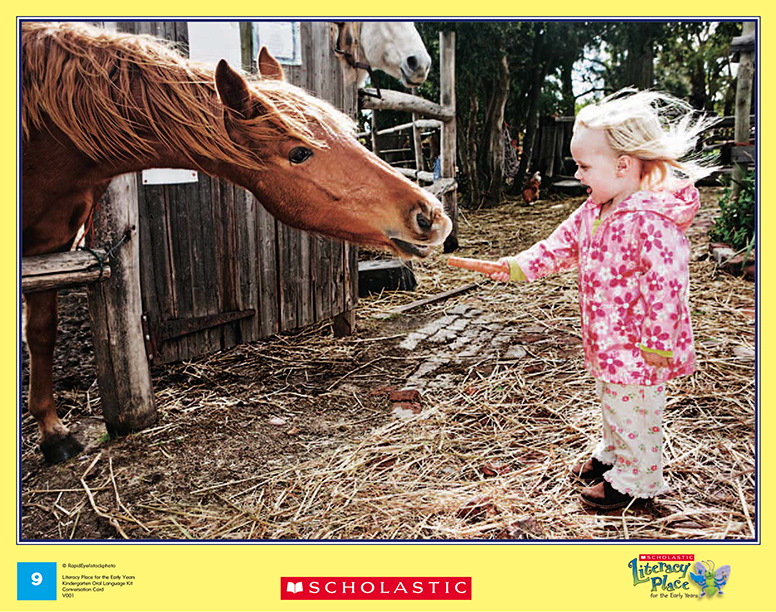Oral Language Teaching Strategy:
Extend and Check the Meaning Expand on the language and details in students’ communication to check the meaning.
Time: one 30-minute lesson or two 15-minute lessons
Materials: Emotions/Interactions Card #9
Grouping: whole class or small group
Assessment: Kindergarten Oral Language Assessment Scale
FOCUSING ON THE PICTURE
[Analyzing/inferring]What is happening in this picture? What can you tell me about where this picture was taken?
Show students the picture. Ask them to look at it and think about what they see and what they think is happening.
- Invite students to share their ideas about the picture with a partner.
- Provide time for partner discussion and then invite a few partners to share their thinking with the group.
- Offer the following prompts to stimulate discussion:
- Who is the girl in this photograph?
- Where do you think this girl is?
- Is this where she lives? What makes you think that?
- What type of day is it? (sunny, windy, rainy) How do you know?
Teaching Tip: You may choose to discuss this conversation card before or after a field trip to a farm to build students’ background knowledge.
GOING DEEPER
[Inferring/evaluating]- Offer prompts that focus the students on the emotions and interaction portrayed:
- How does the girl feel? How do you know?
- Why do you think the girl is laughing?
- Who do you think the girl is with? Why do you think this?
- Do you see the other horse? What do you think that horse is thinking?
Marty, you said you thought the girl was not sure about feeding the horse? Do you mean that the girl is scared to feed the horse? I think I might be afraid to feed a horse for the first time.
- As students answer the questions, extend on their language and details to check their meaning.
You may conclude the lesson at this point and do the second part on the next day, or you may decide to continue and do Connecting and Predicting as part of the first lesson.
CONNECTING
Teaching Tip: If you decide to do Connecting and Predicting on the second day, begin your lesson by reviewing the picture with the students.
[Making connections]- Ask students to connect their personal experiences with the emotions and interactions in the picture. Prompts might include:
- Have you ever been to a farm or a petting zoo? Do you remember what it was like?
- Do you like to eat carrots? What do you like to eat for a treat?
- What do you feel like when you are around different animals? Why do you feel this way?
Fahad: Scared.
Teacher: Fahad, when you said scared, did you mean you were scared of the larger animals like the cows and the horses?
PREDICTING
[Predicting]- Ask students why they think the little girl is at the farm and what else she might do there. If students do not have prior knowledge about farm life you could support the conversation by asking students to brainstorm different animals that might be found at a farm and expand on the students’ suggestions.
Joseph: I think pigs…
Teacher: Yes, pigs can be found at a farm. They also like to eat vegetables.
I wonder if the horse will eat the whole carrot in one bite or will the horse nibble on it until the carrot gets shorter and shorter. What do you think? What will the girl do?
Ask students to think about what might happen after the scene shown in the photograph.
LESSON EXTENSIONS
- Use the picture as the basis for a shared writing lesson. Collect ideas from the students and collaborate on building 2 to 3 sentences about the scene.
- Use the shared writing account as a shared reading text and reread with the students.
- Provide a copy of the shared writing text in the reading centre so students can return to it at a later time.
- With students, create several captions or speech bubbles for the picture like ‘Carrots are good for you and horses.’ Then post the picture at the writing centre for students to add their own speech bubbles or captions. Return to the text and read it with the students.
FOLLOW-UP IN CENTRES
- Students can create their own puppets of the horse and the girl using a variety of materials at the art centre. They can use the puppets to role-play the situation shown in the picture.
- Select one student to sit on a chair at the carpet in front of the other students. Place a mystery item related to a farm under the chair. Show all the students the item except for the child sitting on the chair. Have the student who is sitting on the chair ask questions about the mystery item like, “Is it an animal?” “Does it live on a farm?” “Does it make a sound like ‘moo’?” “Does it begin with the letter C?” Have the other students answer the questions. This activity is great for all the students and encourages students to add detail to their questions. This game may need to be modelled before you have students try it.

